We were taken by surprise when R proposed a trekking trip during Diwali, since strenous holidays are strictly against his Take-It-Easy-Policy. Some planning and several drop-outs later, we found ourselves on the late Friday night flight to Pune. Amazingly enough, we woke bright and early the next morning and were soon on our way to Sinhagad, one of several forts which dot the Sahyadri landscape. Sinhagad is Pune’s equivalent of Nandi Hills in Bangalore, and on weekends is attacked by the holiday crowd, mostly young couples on a romantic getaway. There is a motorable road right to the top of the hill, from where the fort is a short climb away. However, Pune is a city of climbers, and there are many Puneris who climb the fort (from the base) every week, by way of entertainment.
Sinhagad, 25 Oct ’08
My interest in the trip was a visit to Sinhagad valley, apparently a great place for birding, especially with the winter migrants coming in. I had seen the lovely pictures posted in Vivek Kale’s blog, and my mouth was watering at the prospect of shooting these beauties by the watering hole. My companions however, have no such diversions in mind, and as we stop to ask directions to Atkarwadi village, from where the trek starts, they settle into a watering hole of their own – a restaurant that holds a promise of steaming hot pohe to be produced in the distant future. I fret and fume as our early advantage melts away, and by the time we finally make our way to Atkarwadi, I have already reconciled myself to a morning of dismal birding.
We ask our driver to go back to the motorable road and pick us up at the top, and the rest of the group proceeds to climb, while I promptly abandon them and take a path around the base of the hill, determined to explore the valley and possibly locate the watering hole. Immediately start hearing a variety of birdsong, and soon run into a large group (or possibly 2 different groups) of birders. As is usual in such circumstances, they seem taken aback at finding a woman birder wandering around on her own, and maintain an awkward silence. I can’t locate the watering hole, but continue birding along a path that climbs up steeply through the undergrowth.
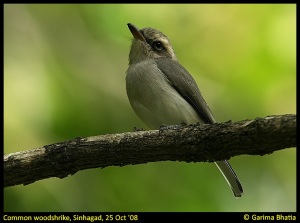 A close encounter with a common woodshrike, which is so full of curiosity that everytime my shutter clicks, it listens intently with its head cutely on one side and flies a little closer to me, as if trying to figure out the source of that strange sound. Further on, a pair of rufous treepies are busy pecking at the gigantic leaves of a tree, and are easy to locate due to the rustling sound they made. Also seen: a black-naped monarch, Tickell’s blue and paradise flycatchers.
A close encounter with a common woodshrike, which is so full of curiosity that everytime my shutter clicks, it listens intently with its head cutely on one side and flies a little closer to me, as if trying to figure out the source of that strange sound. Further on, a pair of rufous treepies are busy pecking at the gigantic leaves of a tree, and are easy to locate due to the rustling sound they made. Also seen: a black-naped monarch, Tickell’s blue and paradise flycatchers.
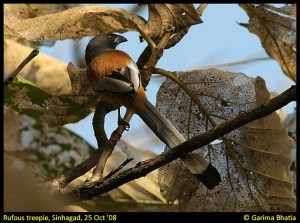 At this point the route I am taking joins up with the main trekking path, and I decide to attempt the climb to the top after all. The initial enthusiasm soon wilts in the heat, and I stop for a refreshing glass of ‘taak’ (buttermilk). The best part about hiking to these touristy forts in Maharshatra is that every 50m or so you find a stall selling nimbu-pani, buttermilk, or sugarcane juice. This is a boon for those lugging around heavy cameras (such as yours truly) as the need to carry water is eliminated. Besides, you can always pretend to be thirsty, while in reality all you want is to sit down for a few minutes and rest your tired knees. A short climb later, I am ready for ganne-ka-ras, and chatting with the fellow running the stall, I find that my companions also stopped here and have moved on a while back.
At this point the route I am taking joins up with the main trekking path, and I decide to attempt the climb to the top after all. The initial enthusiasm soon wilts in the heat, and I stop for a refreshing glass of ‘taak’ (buttermilk). The best part about hiking to these touristy forts in Maharshatra is that every 50m or so you find a stall selling nimbu-pani, buttermilk, or sugarcane juice. This is a boon for those lugging around heavy cameras (such as yours truly) as the need to carry water is eliminated. Besides, you can always pretend to be thirsty, while in reality all you want is to sit down for a few minutes and rest your tired knees. A short climb later, I am ready for ganne-ka-ras, and chatting with the fellow running the stall, I find that my companions also stopped here and have moved on a while back.
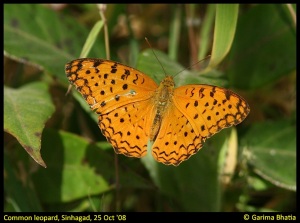 How much farther to the top, I ask? Half an hour, is the answer. I trudge on and reach a flat stretch of rocks, to the right of which a path meanders enticingly off amidst vegetation, in stark contrast with the harsh, bare, rocky climb of some 45 degrees inclination. Seems unlikely that this is the right trail, since we do have to climb to the top, but my feet refuse to listen, and make their way down this lovely path with grassy slopes and butterflies in profusion. 20 minutes later, I grudgingly admit that things don’t look right, and make a patchy mobile call to the others – who are happily munching pakodas at the top – during which I somehow manage to convey that I am lost. I carefully retrace my steps, luckily it is not hard, and resume the climb just above the sugarcane stall. 10 minutes later, another stop for taak, this time a lady vendor. Are you climbing alone? No, the others have gone ahead, I reply. How much farther, I ask? Half an hour.
How much farther to the top, I ask? Half an hour, is the answer. I trudge on and reach a flat stretch of rocks, to the right of which a path meanders enticingly off amidst vegetation, in stark contrast with the harsh, bare, rocky climb of some 45 degrees inclination. Seems unlikely that this is the right trail, since we do have to climb to the top, but my feet refuse to listen, and make their way down this lovely path with grassy slopes and butterflies in profusion. 20 minutes later, I grudgingly admit that things don’t look right, and make a patchy mobile call to the others – who are happily munching pakodas at the top – during which I somehow manage to convey that I am lost. I carefully retrace my steps, luckily it is not hard, and resume the climb just above the sugarcane stall. 10 minutes later, another stop for taak, this time a lady vendor. Are you climbing alone? No, the others have gone ahead, I reply. How much farther, I ask? Half an hour.
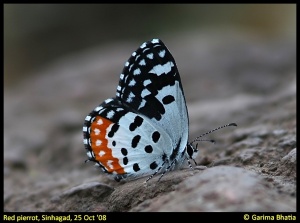 Back to the lonely hill, another 10 minutes of climbing, and I hear R shouting my name from somewhere down below. Amazed, I reply back and wait till he catches up. Rather flattering to think that he climbed back down in the unforgiving heat to look for his lost wife, and nice to have company for the remaining climb ahead. How much farther? Half an hour, he replies. Liars all. I concentrate on putting one front ahead of another while the sun beats down directly overhead. Drenched in sweat, I drag myself to the top, where a lovely Red Pierrot rewards me for my pains with a pretty pose. Certainly not a “picnic hike”, as R first described it!
Back to the lonely hill, another 10 minutes of climbing, and I hear R shouting my name from somewhere down below. Amazed, I reply back and wait till he catches up. Rather flattering to think that he climbed back down in the unforgiving heat to look for his lost wife, and nice to have company for the remaining climb ahead. How much farther? Half an hour, he replies. Liars all. I concentrate on putting one front ahead of another while the sun beats down directly overhead. Drenched in sweat, I drag myself to the top, where a lovely Red Pierrot rewards me for my pains with a pretty pose. Certainly not a “picnic hike”, as R first described it!
Karla, 26 Oct ’08
If you can’t lick ’em, join ’em. I decide to give up hopes of early morning birding, and join the customary pre-trek pigging session with gusto. Hot vada pavs and pohe are consumed en route to Karla caves, and we arrive well-fed and sated. Karla consists of a complex of ancient rock-cut Buddhist caves dated around 2nd century B.C. Climbing the steps to the caves, I am bemused to find rows upon rows of shops selling assorted puja offerings (of a Hindu nature). The reason becomes clear as we arrive at the top – there is a huge temple (certainly NOT dated 2nd century BC) that stands bang in front of the entrance to the main cave. Blaring devotional music and complete with gigantic cut-outs of the illustrious Thackerays. We quickly tour the caves and make our departure, our aim being to find the route to the flat section atop the caves, which runs in a curve across the hills, and is part of a trekking route, according to the Sahyadri trekking Bible by Harish Kapadia.
 We are joined by a canine friend from the village, who starts the climb with us. The route to the top is narrow and steep, and we are glad to be going up and not down! When we finally get there, the top of the hill takes our breath away. A lovely grassland stretching for miles, a gentle breeze that instantly cools us down, and not a soul in sight. It’s like a magic world has just opened up before us. We decide to walk across the grassland and hope to reach one of the lakes or the dam mentioned in the book, at which point our driver could then pick us up. I am thrilled to find a crested lark posing on a rock. The occasional bushchat and ubiquitous bulbuls apart, not much else reveals itself by way of photo-ops.
We are joined by a canine friend from the village, who starts the climb with us. The route to the top is narrow and steep, and we are glad to be going up and not down! When we finally get there, the top of the hill takes our breath away. A lovely grassland stretching for miles, a gentle breeze that instantly cools us down, and not a soul in sight. It’s like a magic world has just opened up before us. We decide to walk across the grassland and hope to reach one of the lakes or the dam mentioned in the book, at which point our driver could then pick us up. I am thrilled to find a crested lark posing on a rock. The occasional bushchat and ubiquitous bulbuls apart, not much else reveals itself by way of photo-ops.
Over the next 4 hours we meander across the terrain, crossing ridges, following electric pylons, clambering up and down rocks, occasionally fighting our way through thick undergrowth, but most of the time walking through almost waist-high grasses that itch and ‘bite’. We’re a bit short of water, and not sure of the path, but we continue on, enchanted by the views and the landscape. We meet a herd of cows that seems terrified to see us. Absolutely no sign of any cowherd, though. At one point, it seems like we’ve lost our way, but our faithful canine companion, who has stuck with us all this while, leads on and brings us back to the path. We reward her with some biscuits and continue downhill through a path that follows a dried up stream, finally emerging at a village at the base of the hill. On the village outskirts, we find a tap, and revel in the chlorine-filled water. Ten minutes later our driver is there to pick us up, our doggy friend has conveniently disappeared, and we head back after a most satisfying hike.
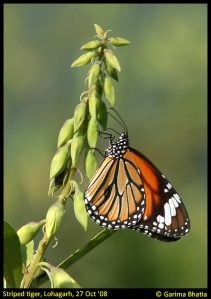 Lohagarh, 27 Oct ’08
Lohagarh, 27 Oct ’08
We’re joined by a friend from Mumbai today, who we’ve lured with the promise of Rajmachi, but we chicken out at the thought of a 20km hike, and instead decide to head to Bhaje, a set of caves opposite Karla, beyond which are two forts – Lohagarh and Visapur. We start the trek from Malavalli village, at the base of the hill. The heat is felt right from the start, and I decide to take it slow and easy and enjoy the numerous butterflies en route. I find striped and blue tigers side-by-side, enjoying the wild flowers. Tiny little butterflies are in profusion, and it is amazing to observe them through the lens and notice the beautiful patterns on their wings. I find Common Cerulean, and many more that I can’t identify.
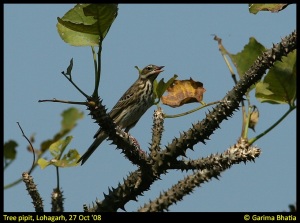 The path to the fort seems to stretch on and on, all around the hill. The others have gone ahead, and at one point I am not sure of the path and decide to turn back, the heat is getting to me, and I am low on energy. R catches up with me, and we decide to try to reach Bhaje caves on our way back, and instead find the correct path which would have led us directly to the fort. At this point we are too tired to try, and I settle for shooting some more butterflies and hopefully some birds other than the bl**** bulbuls. Luckily, a tree pipit shows up, conspicious with its persistent call. I also meet a curious crab, and a lovely damselfly with blue wings, which makes hiking in the hot sun seem not so crazy after all!
The path to the fort seems to stretch on and on, all around the hill. The others have gone ahead, and at one point I am not sure of the path and decide to turn back, the heat is getting to me, and I am low on energy. R catches up with me, and we decide to try to reach Bhaje caves on our way back, and instead find the correct path which would have led us directly to the fort. At this point we are too tired to try, and I settle for shooting some more butterflies and hopefully some birds other than the bl**** bulbuls. Luckily, a tree pipit shows up, conspicious with its persistent call. I also meet a curious crab, and a lovely damselfly with blue wings, which makes hiking in the hot sun seem not so crazy after all!
More pics:












